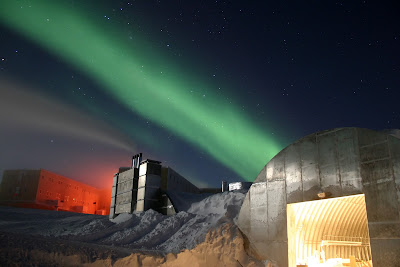I'd like to spend a winter in the high latitudes and experience as many aurora shows as possible. Sometime in the next three years would be ideal, according to Astronomy Picture of the Day:
Auroras are occurring again with increasing frequency. With the Sun being unusually dormant recently, however, our Sun has become increasingly active and exhibiting a greater abundance of sunspots, flares, and coronal mass ejections. Solar activity like this typically expels charged particles into the Solar System, some of which may trigger Earthly auroras. As this year unfolded, the above timelapse displays of picturesque auroras were captured above Tromsø, Norway. Curtains of auroral light, usually green, flow, shimmer and dance as energetic particles fall toward the Earth and ionize air molecules high up in the Earth's atmosphere. With solar maximum still in the future, there may be opportunities to see spectacular aurora over the past three years, the amount of Sun-induced auroras has also been unusually low. More personally over the next three years.
(Image courtesy NASA.)
This amazing composite and its explanation appeared on a 2006 Earth Observatory page:
From space, the aurora is a crown of light that circles each of Earth’s poles. The IMAGE satellite captured this view of the aurora australis (southern lights) on September 11, 2005, four days after a record-setting solar flare sent plasma—an ionized gas of protons and electrons—flying towards the Earth. The ring of light that the solar storm generated over Antarctica glows green in the ultraviolet part of the spectrum, shown in this image. The IMAGE observations of the aurora are overlaid onto NASA’s satellite-based Blue Marble image. From the Earth’s surface, the ring would appear as a curtain of light shimmering across the night sky.
Since Norway and Alaska aren't in my immediate travel future, guess I'll just have to enjoy the aurora internetis—open access at all latitudes and in all seasons. Hope you enjoy too. (Credits below.)
- Credit: Joshua Strang, USAF, Wikipedia.
- Photo by well_lucio, at Flickr.
- Photo by Roskifte, Thomas Roskifte, at Flickr.
- Photo by Soytnly, at Picassa.
- Photo by Samuel Blanc, courtesy Wikimedia Commons.
- Photo by Donald R. Pettit, Expedition Six NASA ISS science officer, on board the International Space Station, courtesy NASA.
- Credit: Image Science and Analysis Laboratory, NASA-Johnson Space Center: "The Gateway to Astronaut Photography of Earth."
- Photo by Chris Danals, National Science Foundation.
- Credit & Copyright: Dave Ewoldt (Okarche, Oklahoma), from APOD.
- Photo by Akhmetsafin Ruslan,at Spaceweather.
- Photo by Sylvain Serre, at Spaceweather.
- Credit & Copyright: Ole Christian Salomonsen, at APOD.
(Aurora Borealis. 1865. Frederic Edwin Church.)
Finally, this illumination by one of my favorites, Frederic Edwin Church. The painting was apparently intended to be a metaphoric omen of the coming Civil War. From the exhibition label at the Smithsonian:
The ship and sled team in this image belonged to Frederic Church's friend, polar explorer Dr. Isaac Hayes. Hayes had led an Arctic expedition in 1860, and gave his sketches from the trip to the artist as inspiration for this painting. Hayes returned from his voyage to find the country in the thick of the Civil War, and in a rousing speech vowed that "God willing, I trust yet to carry the flag of the great Republic, with not a single star erased from its glorious Union, to the extreme northern limits of the earth." Viewers understood Church's painting of the Aurora Borealis (also known as the northern lights) as a portent of disaster, a divine omen relating to the conflict.


























0 comments
Post a Comment